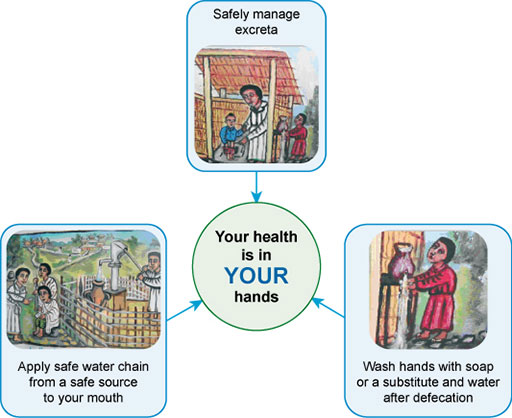1.1 Exclusion and inclusion in WASH
In Ethiopia, millions of people lack access to water, sanitation and hygiene (WASH) services. Lack of access means insufficient, unsafe or distant water, unimproved latrines or open defecation, and inadequate facilities for washing. The three components of water, sanitation and hygiene combine to have a significant impact on human health (as illustrated in Figure 1.1) and on school attendance, productivity, well-being and general quality of life.

In 2015, less than half the total Ethiopian population of nearly 100 million was reported to have access to a basic water supply and only 7% and 1% respectively to basic sanitation and hygiene facilities (JMP, 2017). These data, for the population as a whole, show that the country has a long way to go to improve the availability of WASH services.
Imagine you are a young woman living in a rural area who does not have access to WASH services. How could this affect your daily life?
There are many possible effects but you may have thought of:
- spending much of your time collecting water for the family and carrying a heavy jerrycan on your back
- not having enough water for personal or family washing and household chores
- waiting until dark to go into the fields to find a place to defecate and feeling vulnerable to attack
- being unable to wash your hands after defecation or before preparing food
- suffering from frequent diarrhoea caused by contaminated/unsafe water
- finding it difficult to keep clean and to wash sanitary pads during your monthly period.
An important part of the challenge ahead for Ethiopia is to ensure that improvements in WASH services will reach everyone and that no one is excluded. Exclusion from WASH means a person or group of people are prevented from having access to water, a toilet or handwashing facility, or where access is very difficult for them. Different people have different needs, but this is not always taken into account by planners, designers and decision makers. When we talk about exclusion, we are talking about people who are left behind in terms of getting access to WASH because their needs have not been recognised or considered important.
Inclusion is the opposite of exclusion. Inclusion in WASH means that everyone has access to safe WASH facilities and the needs of all members of a given community, regardless of who they are and their circumstances, are fully addressed in the design, planning and implementation of WASH services. Everyone benefits from inclusive WASH. To give one example, inclusive latrines in a school would have separate blocks for girls and boys, with flat, level paths and handrails for accessibility, with water and basins for handwashing, and appropriate facilities for menstrual hygiene management. Accessibility, in this context, refers to designs, structures and services that are usable (accessible) by people who have limited mobility (the ability to walk) or other disabilities.
It is important to realise, however, that the process of inclusion is not only about making sure that excluded people have access to services but also about helping them to participate fully in the decisions about those services (Gosling, 2010). If they are fully involved in the process their needs will be recognised and they can realise their rights to water, sanitation and hygiene.
There are therefore two aspects to inclusion: access to services and participation in planning and decision-making processes. It follows from this definition that it is possible to be excluded in a number of different ways. For example, some people may not have access because they are physically unable to turn a water tap or walk up steps to a latrine but others may be excluded because their opinions are not considered important and they are ignored by the people who make decisions.
Learning Outcomes for Study Session 1
